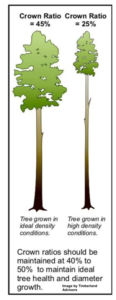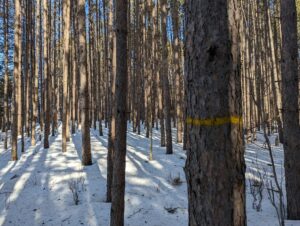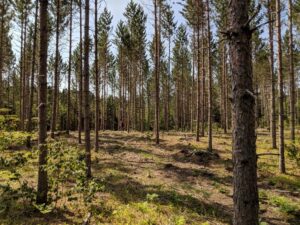The forest surrounding Fond du Lac Tribal and Community College is undergoing a selective harvest. This tree thinning is intended to improve the overall health and longevity of the remaining trees, improve fire safety on campus, and allow for the long-term regeneration of a more species-rich and age-diverse forest.
The forest surrounding Fond du Lac Tribal and Community College is undergoing a selective harvest. This tree thinning is intended to improve the overall health and longevity of the remaining trees, improve fire safety on campus, and allow for the long-term regeneration of a more species-rich and age-diverse forest.
Fond du Lac Tribal and Community College sits within a community of trees that is largely a remnant timber plantation. In the 1950s, Potlatch Forests, Inc. (PFI) clearcut this land and planted red pine to be harvested for timber products after 60-90 years. In 1991, the State of Minnesota appropriated the land for the construction of Fond du Lac Tribal and Community College.
The trees within the remnant plantation are a monoculture—they are the same species, the same age, and planted very tightly together. As it stands now, these trees do not have the space to grow to old age and are at much greater risk of succumbing to disease or high-intensity fire.
In contrast, healthier pine forests show complexity and diversity in age, structure, species, and distribution of individuals, with resiliency towards low intensity fires on the landscape.
Each tree selected for harvest was offered asemaa (tobacco) in gratitude and as a request for permission to be harvested.
The following principles guided tree selection:
- Appropriate Spacing
- Crown ratio
- Removal of unhealthy or injured individuals
- Fire safety
- Reduced risk of treefall damage to campus infrastructure
- Aesthetics
Harvested trees suitable for milling will be sold to a lumber mill by our contracted logger to help offset the project’s costs. All other woody material will be chipped and used on campus for trail improvements, landscaping, gardening, and composting.
President Anita Hanson has assembled a team of FDLTCC faculty and staff, as well as forestry professionals from Fond du Lac Band of Lake Superior Chippewa Resource Management and the University of Minnesota Cloquet Forestry Center, all with a shared interest in collaborating to protect the future health, safety, and longevity of our campus forest. FDLTCC students have also been involved in planning meetings and tree marking activities. This project has been incorporated into current college courses and will continue to be part of long-term ecological research projects.
Values:
- Manaaji’idiwin (Respect)
- Gwayakwaadiziwin (Integrity)
- Ganawenjigewin (Stewardship)
- Maamamiikaajinendamowin (Innovation)
- Zhawenjigewin (Compassion)
Goals:
- Improved disease resistance and longevity
- Improved infrastructural and fire safety
- Increased opportunity for forest complexity and biodiversity
- Improved habitat quality
- Improved outdoor learning space
- Future underplanting of a diverse collection of native species
- Improved community access to culturally relevant foods and medicines
- Eventual reintroduction of cultural burning practices
Yes, President Hanson has invited a small group of campus and community leaders to Fond du Lac Tribal and Community College to begin this project in a good way.
Selective harvesting may begin as soon as Friday, April 12th, 2024.
At this time, this project is estimated to take about 6 weeks to complete. Given the many different variables and complexities of this project, the timeline may be subject to change
Signage will be posted throughout campus marking closures and appropriate parking locations.
Please carefully follow all posted signage, and do not walk in restricted areas. All of FDLTCC campus’s trails and forested areas will be closed to foot traffic beginning Wednesday, April 10th, 2024, until the completion of the project.





